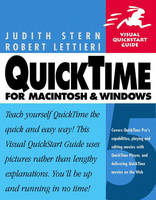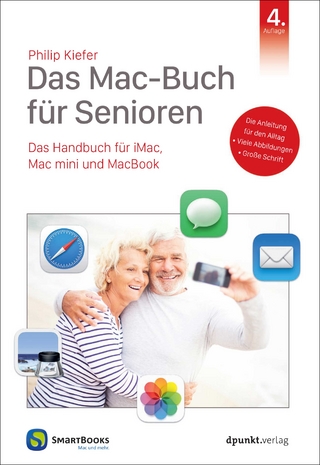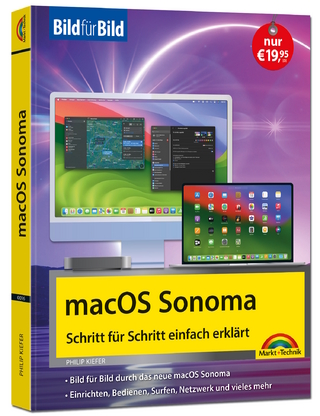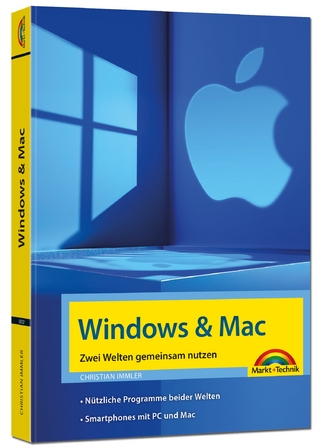
QuickTime 5 for Macintosh and Windows
Peachpit Press Publications (Verlag)
978-0-201-74145-2 (ISBN)
- Titel ist leider vergriffen;
keine Neuauflage - Artikel merken
For any course in Digital Graphics, Web Design, Web Scripting and Development, Multimedia, Page Layout, Office Tools, and Operating Systems.
These task-based, visual reference guides feature step-by-step instructions and plenty of screen shots to guide students and teachers through the most important tasks. Visual QuickStart Guides are the ideal way to get students up and running quickly, and are used for intermediate and advanced students as a quick reference.
Judith Stern is a multimedia specialist, software designer and technical writer who works for the University of California at Berkeley on several educational research projects. Robert Lettieri is a graphics and multimedia specialist at the University of California at Berkeley, working on NEEDS, a Digital Library for Engineering Education.
Introduction.
1. QuickTime Basics.
Differences Between the Pro and Standard Editions. Checking for QuickTime 5. Checking for the Pro Edition. Hardware and Software Requirements. Obtaining and Installing QuickTime 5. Upgrading to QuickTime Pro 5. Getting QuickTime Updates and Missing Components. About the QuickTime Interfaces. Using AppleScript to Control QuickTime (Mac OS only).
2. QuickTime Player Basics.
About the QuickTime Player Window. Opening QuickTime Movies. Opening Non-QuickTime Files. Converting Non-QuickTime Files. Opening Files on the Internet. Opening Channels and Favorites. Adding and Organizing Favorites. Changing Window Sizes. Getting Basic Information About a Movie. The Properties Window. About Preferences.
3. Controlling Movies in the Player.
Playing and Pausing Movies. Changing the Audio Level. Randomly Accessing Points in a Movie. Stepping Through a Movie Frame by Frame. Fast-Forwarding and Fast-Reversing a Movie. Changing Balance, Bass, and Treble. Presenting a Movie. Presenting a Movie Frame by Frame (in Slide-Show Mode). Looping a Movie or Playing It Backward. Playing Every Frame. Playing and Pausing All Open Movies. Checking the Frame Rate. Changing Video Settings. Using Chapter Lists. Choosing a Language for Playback. Searching a Text Track.
4. QuickTime VR in the Player.
Looking Around in Panorama Movies. Manipulating Objects in Object Movies. Finding and Using Hot Spots. Zooming In and Out. Moving Zoomed-In Objects. Presenting QuickTime VR Movies.
5. The QuickTime.
Standard Controllers. Playing and Pausing Movies. Stepping Through a Movie Frame by Frame. Randomly Accessing Points in a Movie. Varying a Movie's Playback Rate. Using Chapter Lists. Changing the Audio Level. Overdriving Audio. Finding and Using VR Hot Spots. Zooming In and Out of VR Movies. Moving Zoomed-In VR Objects. Saving Movies on the Web.
6. Basic Movie Editing.
Selecting and Deselecting Movie Data. Jumping to the Beginning or End of a Selection. Playing Only What's Selected. Getting Time Information About the Movie and Selection. Copying and Cutting Movie Data. Having Multiple Windows Open in QuickTime Player. Pasting Movie Data into a Movie. Pasting Text and Graphics into a Movie. Creating a New Movie and Pasting Movie Data into It. Combining Two Movies. Deleting Parts of a Movie. Replacing Part of a Movie with a Portion of Another. Drag-and-Drop Editing. Adding and Editing Annotations. Changing What Appears in the Movie Info Window. Setting a Poster. Setting a Preview. Setting a Preview with Data from Other Movies. Setting a Movie to Play Automatically When Opened. Saving Movies. Checking File Dependencies.
7. Working with Tracks.
Determining Which Tracks a Movie Contains. Combining Tracks with the Add and Add Scaled Commands. Extracting Tracks. Deleting Tracks. Disabling and Enabling Tracks. Scaling a Track to a Specific Duration. Setting Up Tracks with Alternate Languages. Specifying a Language for a Track. Designating a Set of Alternate Tracks. Loading Tracks into Memory.
8. Working with Visual Tracks.
Flipping, Rotating, Resizing, Repositioning, and Skewing. Masking a Visual Track. Placing Visual Tracks Side by Side. Creating a Picture-in-a-Picture Effect. Relayering Tracks. Making a Color Transparent in a Track. Blending Tracks. Using Alpha Channels. Adding Visual Data to QuickTime VR Movies. Adding a Custom Color Table to a Movie. Creating a Still-Image File from a Movie Image. Creating a Set of Still Images from a Movie. Creating a FLC Animation from a Movie. Adding a Media Skin to a Movie.
9. Video and MPEG Tracks.
About Video Compression. About the Compression Settings Dialog Box. Determining How a Video Track Was Compressed. Creating Video Tracks from a Sequence of Still Images. Creating a Video Track from a Single Still Image. Creating Video Tracks from Non-QuickTime Animation and Video Files. Adding Images to an Existing Movie. Creating MPEG Tracks from MPEG Files.
10. Text Tracks.
Creating a Text Track by Importing a Text File. Specifying Text Track Appearance When You Import (Mac OS 9 and Windows). Specifying the Duration and Appearance of Individual Frames of Text. Exporting a Text Track with Text Descriptors and Time Stamps. Creating a Text Track That's Synced to Other Tracks. Changing Text That's Already in a Text Track (Mac OS only). Adding Small Amounts of Text. Creating Chapter Lists.
11. Sprite, 3D, and Flash Tracks.
About Sprite Tracks. Attaching a Graphic or Video Sequence to a Sprite. Changing the Background Color of a Sprite Track. Changing Properties of Sprite Tracks. About 3D Tracks. Creating a Static 3D Track from a 3D File (Mac OS 9 and Windows only). Changing Texture Mapping for a 3D Track (Mac OS 9 and Windows only). Changing the Renderer for a 3D Track (Mac OS 9 and Windows only). About Flash Tracks. Creating Flash Tracks from Flash Files.
12. Working with Audio Tracks.
Adding New Audio to a Movie. Adding Still Images to an Audio Track. Having Audio Play When the Movie Isn't in Front. Changing the Default Volume, Balance, Bass, and Treble.
13. Sound Tracks and MPEG Audio Tracks.
About Digitized Sound. About the Sound Settings Dialog Box. Checking the Characteristics of a Sound Track. Creating a Sound Track from a Sound File. Creating a Sound Track from an Audio CD (Mac OS Only). Creating an MPEG1 Audio Track from an MPEG-1 Sound File. Changing the Characteristics of a Sound Track. Converting a Music Track to a Sound Track. Using QuickTime Player As a Sound-Conversion Utility.
14. Music Tracks.
Converting MIDI Files to QuickTime. Converting Karaoke Files to QuickTime. Changing Instruments in a Music Track. Substituting a Custom Sound for an Instrument in a Music Track. Playing Music Tracks Through a MIDI Synthesizer. Converting Music Tracks Back to MIDI.
15. Delivery Basics.
About Data Rate and Size. Checking Data Rate and Data Size. Saving Movies for Distribution. Exporting Movies As QuickTime Movies. Applying Filters. Compressing Selected Tracks. Authoring and Presentation Tools That Support QuickTime. Checking the Dimensions of a Movie.
16. Preparing Movies for Streaming.
About Streaming. RTSP vs. HTTP Streaming. Preparing Movies for HTTP Streaming. Preparing Movies for RTSP Streaming. Preparing Movies for Mixed RTSP and HTTP Streaming. Choosing Video Compression Settings. Choosing Sound Compression Settings. Creating Fast Start VR Movies.
17. Creating Web Pages with Movies.
Embedding an HTTP QuickTime Movie in a Web Page. Embedding an RTSP QuickTime Movie in a Web Page. Creating a Poster Movie. Writing the HTML for a Poster Movie. Creating Panorama Thumbnails with QTVR PanoToThumbnail (Mac OS 9 Only). Making an Internet Movie Appear in QuickTime Player.
18. Advanced Techniques for Web Delivery.
Adding Attributes to an EMBED Tag. Specifying the Attributes of a Movie Other Than the SRC Movie. Forcing QuickTime to Open Files. Using HREF Tracks to Open Web Links at Specific Times. Creating Hyperlinks in a Text Track. Storing Plug-In Settings in a Movie. Specifying Web Pages to Load When a User Clicks Inside a Movie. Putting Movies on the Internet That Can't Be Saved. Using Alternate Movies.
19. Movies on CD-ROM and Kiosk.
Preparing Movies for CD-ROM and Kiosk. Video Compression Choices for CD-ROM. Sound Compression Choices for CD-ROM. Compression Choices for Kiosk. About Additional Compressors. Licensing Requirements for Distributing QuickTime.
Appendix A: Mouse and Keyboard Tricks.
Appendix B: Configuring QuickTime.
Opening the QuickTime Settings Control Panel and the QuickTime System Preferences Pane. Using the QuickTime Settings Control Panel and the QuickTime System Preferences Pane.
Appendix C: Resources.
Vendors and Products. Other Resources.
Index.
| Erscheint lt. Verlag | 4.7.2001 |
|---|---|
| Verlagsort | Berkeley |
| Sprache | englisch |
| Gewicht | 662 g |
| Themenwelt | Informatik ► Betriebssysteme / Server ► Macintosh / Mac OS X |
| Informatik ► Grafik / Design ► Digitale Bildverarbeitung | |
| Informatik ► Weitere Themen ► Hardware | |
| ISBN-10 | 0-201-74145-8 / 0201741458 |
| ISBN-13 | 978-0-201-74145-2 / 9780201741452 |
| Zustand | Neuware |
| Haben Sie eine Frage zum Produkt? |
aus dem Bereich


